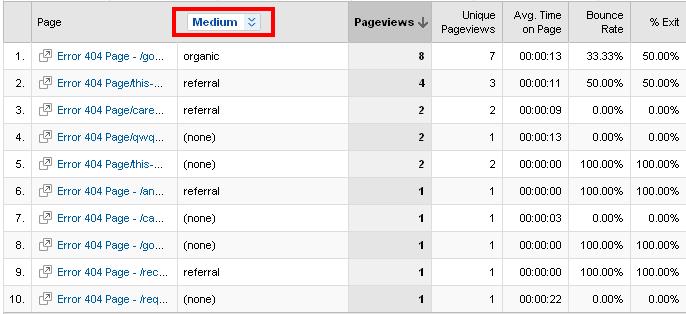John Hossack wrote a great post back in April
“Tracking Error 404 Pages and Broken Links in Google Analytics: Google Analytics Power User 11”. Since then, GA has added one of many new powerful features – Secondary Dimensions. This week’s post is written with thanks to
Dave Klein (Public and Media Relations) who posted the following question on John’s post:
“I’ve gotten so far as the Navigation Summary. My 404’s are appearing in the report but my nav. summary appears blank.” which lead to this blog post for the week. Here’s the quick answer, followed by some consequences: Error pages that will have both 0% Previous Pages and 0% Next Pages are those with 100% Bounce Rates since they are both Entry and Exit pages. The Navigation Summary will list Next Pages for pages with less Bounce Rates or less than 100% and Previous Pages for those that are not Landing Pages.
What this is costing your site?Taking things a step further
In the Top Content report, use the secondary dimension column pull-down and select
Medium. Then filter the report (use
containing: error in the filter at the foot of the table and click Go). The resulting report will look something like this:

Now look at the pages that have 100% Exit Rates, to see where the error caused the visitor to leave the site. If costly mediums brought those visitors to your site, the errors are costing real dollars. By “costly mediums” I don’t only mean AdWords but include Traffic Sources such as organic if your are investing time or money in SEO. Even more insight can be had applying the same technique to the Top Landing Pages report.
How to Tap Power from Secondary Dimensions
If one is just playing around with Secondary Dimensions and, say, displays the Top Content report and selects a Secondary Dimension, say, Keyword (try it!) one can be excused for thinking the GA team should have spent their time more wisely than wasting it on simply producing much more data. The resulting report is unlikely to provide much value. For real insight, the trick is to either start with a subset of data (such as the filtered Error pages) and a Secondary Dimension that has fewer values, such as
Medium rather than
Keywords. Or, start with a report
sorted on the primary dimension and a sparse Secondary Dimension. Find the higher level insights first and then drill down. At the lower levels choose whatever Secondary Dimension will answer your questions, regardless of how sparse because at that drilling depth, the data will be valuable rather than simply a formidable flood of permutations.
Gossip about how the Other Half Live
By all means – take GA for granted, but here’s some juicy gossip. Sorting on dimension columns (as opposed to metrics columns) is not available in some of the most expensive Web Analytics tools out there. And don’t even think of asking for Secondary Dimensions from such tools – certainly not in the basic package.
Other Methods of Tracking Error Pages
Dave also referred us to a similar method, with the advantages being:
- one has the actual referring page (the one containing the broken link) and the missing page in the reported page name. E.g. “/404.html?page=[pagename.html?queryparameter]&from=[referrer]”
- if the referring page is external, one has its URL
The disadvantages are:
- one has additional coding to do and
- each permutation of error #, missing/error page (with its parameters) and referring page is listed individually, making it more difficult to pick out the biggest culprits or most expensive errors.
My recommendations:
- at the very least, ensure that the basic tracking is implemented on your error pages, whether they be standard or custom (once they have GA code, they are custom, strictly speaking)
- if you have a significant problem with 404 errors on pages from external sites, use the method at Google Analytics’ Support page but limit it to pages referred to by external sources that you are not tracking, like google.com. The code snippet below contains the modification to implement the exception. This removes one of the above disadvantages.
- When viewing the Top Content report with these results, choose Medium as the Secondary Dimension and filter the report on containing: &from=
- That report will list broken pages referred by external web sources.

 Now look at the pages that have 100% Exit Rates, to see where the error caused the visitor to leave the site. If costly mediums brought those visitors to your site, the errors are costing real dollars. By “costly mediums” I don’t only mean AdWords but include Traffic Sources such as organic if your are investing time or money in SEO. Even more insight can be had applying the same technique to the Top Landing Pages report.
Now look at the pages that have 100% Exit Rates, to see where the error caused the visitor to leave the site. If costly mediums brought those visitors to your site, the errors are costing real dollars. By “costly mediums” I don’t only mean AdWords but include Traffic Sources such as organic if your are investing time or money in SEO. Even more insight can be had applying the same technique to the Top Landing Pages report.












